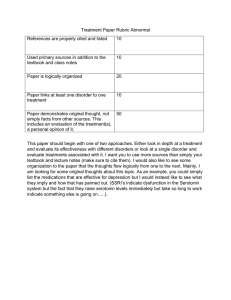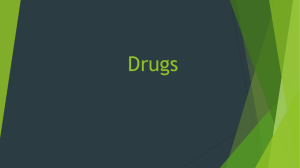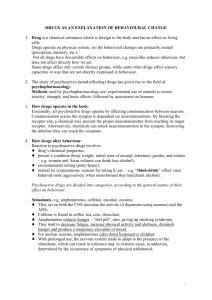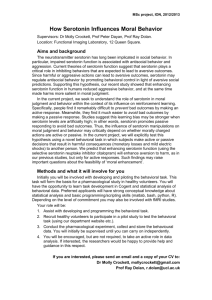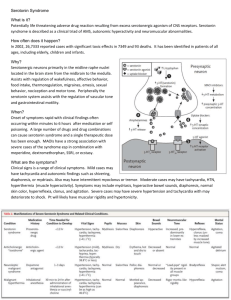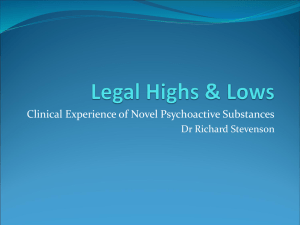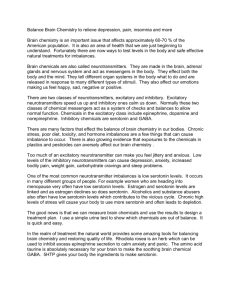FURTHER DISCUSSION OF THE ACETYLCHOLINE-SEROTONIN RELATIONSHIP
advertisement
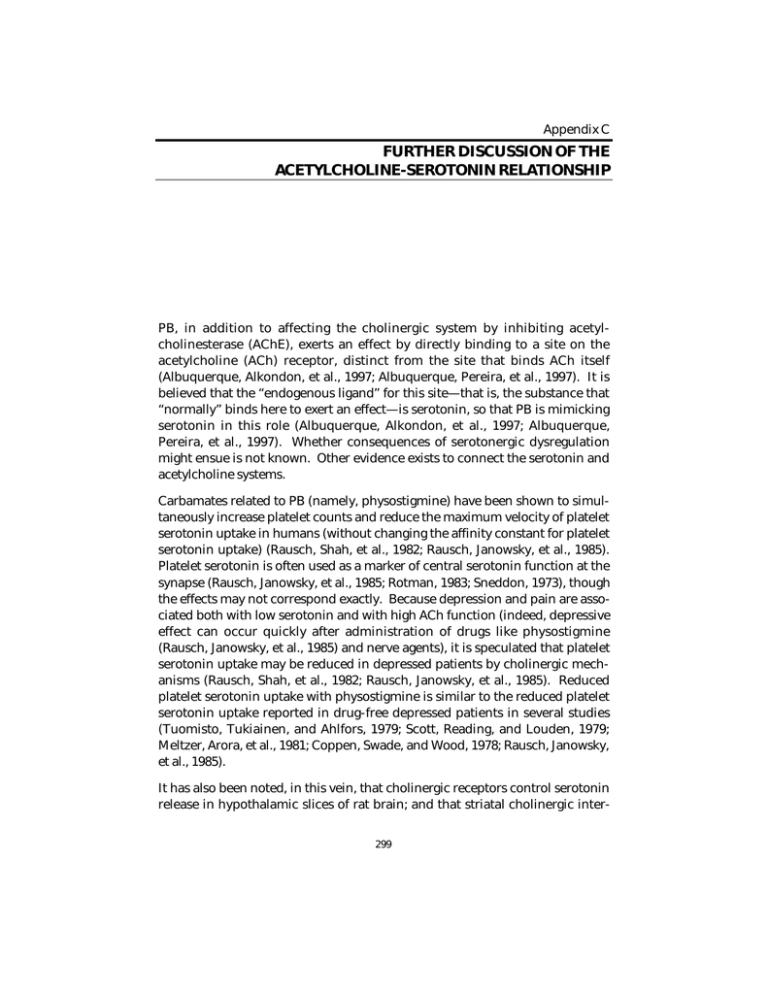
Appendix C FURTHER DISCUSSION OF THE ACETYLCHOLINE-SEROTONIN RELATIONSHIP PB, in addition to affecting the cholinergic system by inhibiting acetylcholinesterase (AChE), exerts an effect by directly binding to a site on the acetylcholine (ACh) receptor, distinct from the site that binds ACh itself (Albuquerque, Alkondon, et al., 1997; Albuquerque, Pereira, et al., 1997). It is believed that the “endogenous ligand” for this site—that is, the substance that “normally” binds here to exert an effect—is serotonin, so that PB is mimicking serotonin in this role (Albuquerque, Alkondon, et al., 1997; Albuquerque, Pereira, et al., 1997). Whether consequences of serotonergic dysregulation might ensue is not known. Other evidence exists to connect the serotonin and acetylcholine systems. Carbamates related to PB (namely, physostigmine) have been shown to simultaneously increase platelet counts and reduce the maximum velocity of platelet serotonin uptake in humans (without changing the affinity constant for platelet serotonin uptake) (Rausch, Shah, et al., 1982; Rausch, Janowsky, et al., 1985). Platelet serotonin is often used as a marker of central serotonin function at the synapse (Rausch, Janowsky, et al., 1985; Rotman, 1983; Sneddon, 1973), though the effects may not correspond exactly. Because depression and pain are associated both with low serotonin and with high ACh function (indeed, depressive effect can occur quickly after administration of drugs like physostigmine (Rausch, Janowsky, et al., 1985) and nerve agents), it is speculated that platelet serotonin uptake may be reduced in depressed patients by cholinergic mechanisms (Rausch, Shah, et al., 1982; Rausch, Janowsky, et al., 1985). Reduced platelet serotonin uptake with physostigmine is similar to the reduced platelet serotonin uptake reported in drug-free depressed patients in several studies (Tuomisto, Tukiainen, and Ahlfors, 1979; Scott, Reading, and Louden, 1979; Meltzer, Arora, et al., 1981; Coppen, Swade, and Wood, 1978; Rausch, Janowsky, et al., 1985). It has also been noted, in this vein, that cholinergic receptors control serotonin release in hypothalamic slices of rat brain; and that striatal cholinergic inter299 300 Pyridostigmine Bromide neurons are modulated via serotonergic projections from the raphe (Rausch, Shah, et al., 1982; Vizi, Harsing, and Zsilla, 1981; Hery, Burgoin, et al., 1977). Both serotonin and physostigmine have been reported to inhibit cell membrane AChE activity (Rausch, Janowsky, et al., 1985). Cholinergic agonists have been shown to cause a release of serotonin in canine platelets, an effect blocked by muscarinic antagonists (Rausch, Janowsky, et al., 1985). Serotonin nerve endings in rat brain are sensitive to cholinergic stimulation (Hery, Burgoin, et al., 1977; Rausch, Janowsky, et al., 1985). Physostigmine can inhibit serotonin uptake in hypothalamic synaptosomes and can increase extracellular serotonin in rat cortex and hypothalamic slices (Aiello-Malmberg, Bartolini, et al., 1979; Hery, Burgoin, et al., 1977; Rausch, Janowsky, et al., 1985) probably through the special ACh receptor, since this effect does not arise from the anticholinesterase effect (Aiello-Malmberg, Bartolini, et al., 1979) but does appear to be via nicotinic cholinergic stimulation (Westfall, Grant, and Perry, 1983; Hery, Burgoin, et al., 1977; Rausch, Janowsky, et al., 1985). Brain serotonin turnover is increased following administration of cholinesterase inhibitors, including carbamates (physostigmine) as well as organophosphates (OPs) (including soman) (Prioux-Guyonneau, CoudrayLucas, et al., 1982; Pscheidt, Votava, and Himwich, 1967; Kleinrok, JagielloWojtowicz, and Sieklucka, 1975; Haubrich and Reid, 1972; Rausch, Janowsky, et al., 1985). These effects differed in different parts of the brain, being strongest in the striatum, present in most areas of the brain, but absent in the hypothalamus in one study (Prioux-Guyonneau, Coudray-Lucas, et al., 1982). Increased levels of serotonin may be seen with some AChE-inhibiting agents, e.g., soman, but not with others, e.g., DFP. These levels return to normal before restoration of AChE activity, while the serotonin turnover, gauged by levels of the serotonin metabolite 5-HIAA, remains high (Prioux-Guyonneau, coudrayLucas, et al., 1982). There is no proportional relationship between increased turnover and either AChE activity or ACh levels—the serotonin effect continues after ACh levels are expected to have returned to normal (though AChE remains inhibited), and continues to increase while AChE inhibition remains constant or is decreasing (Prioux-Guyonneau, Coudray-Lucas, et al., 1982). Although this effect has been termed “long-lasting,” effects were only evaluated up to 24 hours after administration of soman or paraoxon. AChE inhibitors (namely the OP insecticide parathion) have been shown to enhance the nighttime rise in serotonin “N-acetyltransferase” in the pineal The Acetylcholine-Serotonin Relationship 301 gland, an area involved in production of melatonin and regulation of sleep, and have been shown to increase nighttime serum melatonin levels (Attia, Mostafa, et al., 1995a). This effect is blocked by ß adrenergic blockers and has been speculated to occur at the level of the ß adrenergic receptor or via sympathetic innervation to the pineal gland (Attia, Mostafa, et al., 1995b). The selective serotonin 1D receptor agonist, sumatriptan (used clinically to abort migraine headaches), has been shown to increase growth hormone (a pituitary hormone) released in response to growth hormone releasing hormone (a hypothalamic hormone)—the same effect that PB has on growth hormone. It has been postulated that this may occur by inhibition of hypothalamic somatostatin release—the same mechanism by which PB is thought to influence growth hormone release (see Chapter Fifteen, “Other Effects,” section on hormones (Mota, Bento, et al., 1995). It is tempting to speculate on the relation or possible equivalence between the 5HT1D (serotonin 1D) receptor and the specialized receptor on ACh to which PB and serotonin bind. (No information related to this has been uncovered in the present literature review.) The serotonin-3 antagonist ondansetron did not produce inhibition of AChE by itself when given to guinea pigs (a common animal model for the benefit of PB versus nerve agent); however ondansetron (10 or 20 mg/kg) added to PB increased the inhibition of AChE produced by PB alone (0.94 mg/kg given orally) at all times evaluated, from 30 to 240 minutes (Capacio, Byers, et al., 1993; Capacio, Koplovitz, et al., 1996). (The increases averaged 12 percent (range 10–17 percent) for 10 mg/kg and 16 percent (14–20 percent) for 20 mg/kg of ondansetron; moreover, the slope of recovery of AChE function was slowed when ondansetron was given. Non–peer reviewed reports circulating on the Internet state that treatment with a combination of the serotonergic agent fenfluramine (now pulled from the market because of adverse effects) and the adrenergic agent phentermine, a drug combination formerly popular in the treatment of obesity, produced 50– 100 percent benefit in symptoms in ill PGW veterans as well as in other individuals with symptoms of fibromyalgia (Hitzig, 1997). These were open label trials and this work has in no way been subjected to peer review.
